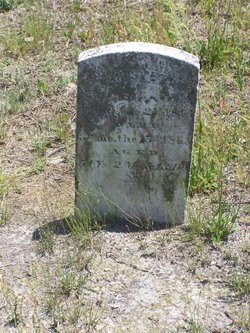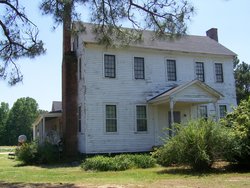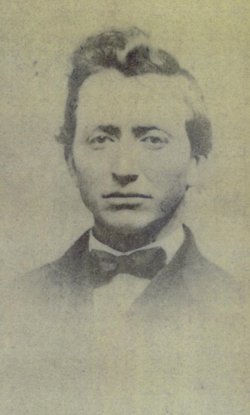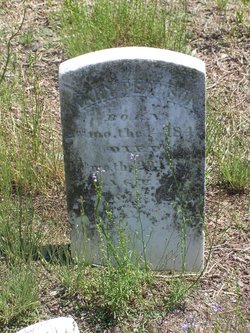| Description |
: |
The following information about Lazarus and Sarah Edgerton Pearson, his brother Jonathan, and other family members is better given by quoting Lazarus' great-granddaughter, Ruth Pearson Harper (1901-1985), in her book "History of the Pearson Family of Wayne County, North Carolina 1700-1981" (1982), pages 45-51:
In 1837 Ichabod (Pearson) II gave Lazarus a farm of 220 acres on Black Creek where he lived until 1842. Then Lazarus bought 1618 acres in Johnston County at Coonsboro, about five miles north of Selma, and lived there about eight years. Then in the early 1850's he moved back to Wayne where he bought about...
Read More
|
The following information about Lazarus and Sarah Edgerton Pearson, his brother Jonathan, and other family members is better given by quoting Lazarus' great-granddaughter, Ruth Pearson Harper (1901-1985), in her book "History of the Pearson Family of Wayne County, North Carolina 1700-1981" (1982), pages 45-51:
In 1837 Ichabod (Pearson) II gave Lazarus a farm of 220 acres on Black Creek where he lived until 1842. Then Lazarus bought 1618 acres in Johnston County at Coonsboro, about five miles north of Selma, and lived there about eight years. Then in the early 1850's he moved back to Wayne where he bought about 1000 acres, part of the John W. Sasser estate, on the south side of Little River at Pearson Bridge. Later he bought about 200 acres more.
Lazarus and Sarah were the first persons buried in the Pearson Cemetery to have marble tombstones erected by the family.
On 3-10-1849 Lazarus and six children--John Thomas, Emory, Nathan, Sarah, Elizabeth, and Mary--were received on request by Contentnea MM (Nahunta). He was the only child of Ichabod II who became a member of a Quaker meeting before the Civil War. Perhaps Sarah had been a member all the time; evidence that the practice of disowning members for marrying outside the church was being relaxed; maybe Lazarus was considered a Quaker at heart.
Lazarus and Sarah were very interested in education and sent their children to New Garden Boarding School (Guilford College 1888). In 1861 Lazarus was appointed to the Board of Trustees. He resigned from the board in 1865, a few weeks before his death.
They brought up their children in a religious atmosphere. They held fast to Quaker principles even at the risk of unpopularity in an unfriendly society of slaveholding secessionists. Two sons, Ichabod Emory and William Lazarus, were ministers of the gospel.
For a more detailed account of their lives we are indebted to "Southern Heroes" by Fernando Cartland (1895; out of print). Certain parts have been summarized for this history of the Pearsons in Civil War times.
In Wayne County there were about sixty families of Friends. All were members of either Neuse or Nahunta meetings (Contentnea MM was laid down in 1863). These substantial citizens who owned no slaves were ostracized and disliked by their slaveholding neighbors, but they were respected because of their moral worth and their financial prosperity.
They were early suspected of holding Union sentiments, and strong efforts were made to induce them to support seccession and later the Confederacy. Attempts were made to make soldiers of those who were opposed to fighting. The properyt of some Quakers was confiscated; then these men were sent to prison where they fared badly.
Lazarus was above the age for conscription. He was one of the managers of the Underground Railroad organized by Levi Coffin, a northern abolitionist. For that he was always suspect, though not much could be proven about his help for a runaway slave.
His brother Jonathan was not a member of Nahunta MM, but he held the same opinions about slavery. In 1854 he proposed to set free the family of Negroes, those formerly owned by Ichabod II, and to send them to Ohio. Being satisfied with their living conditions and also fearful, they refused to accept freedom. Lazarus advised him not to hold them, but he could see no other way. He was also strongly opposed to secession. He was not molested until the Second Conscription Act of September 1862, which called for all able-bodied men under forty. Jonathan lacked six months of forty. Not willing to be captured, he slipped away to the Friends community at Rich Square in Northampton County. The next summer he slipped back home when he heard that his twin children had typhoid fever, but he did not attend the funeral. In late November 1863 he was betrayed by one of his Negro men who had been both threatened and offered rewards. He was sent to Camp Holmes at Raleigh and from there to the Confederate Army on the Rappahannock.
Lazarus soon went to Virginia to secure his release, if possible. He took food and clothing--two suits of homespun and a pair of shoes. He made arrangements for Jonathan to pass the Confederate pickets on December 31, 1863. Jonathan started to wade the river but had to swim the Rappahannock to keep from freezing. He reached the Union lines and was soon sent to prison in Washington. His Uncle William Pearson of New Sharon, Iowa secured his release through a congressman from Iowa. However, this statement does not coincide with his military record. About a year after he left home his family escaped by the Underground Railroad and joined him in Iowa. Finally, in 1874 he joined Nahunta Meeting.
Four letters found in the collection of the Joseph L. Pearson family relate to these events. Two letters by Jonathan and one by Lazarus were addressed to John Bacon Crenshaw, outstanding Quaker minister at Richmond, Va., who had visited Friends meetings in Wayne County. During the war he was very helpful to those who refused to fight or were already in prison as conscientious objectors. After the war John B. Crenshaw returned these letters to the Pearsons. Lazarus wrote from Goldsboro and Jonathan wrote from the Confederate Army camp on the Rappahannock in Virginia.
The first letter from Jonathan is dated 12-3-1863. The English is very poor, but this is the message he conveyed: He is in Confederate camp near Orring (?) Courthouse (probably Orange, Virginia) and has been assigned to the 6th North Carolina Regiment. It is going very badly with him to be there as he is a man of peace and wishes to be at peace with all men. He is waiting to be confronted by the officers. He says he wrote Crenshaw a letter when he was a prisoner at Raleigh. He thinks the letter did not go through and wants advice as to the best course of action.
The second letter is dated 12-6-1863 and this is the message: The officers say he should carry his gun and have had it tied to him all day. They tell him he is no Quaker and has no chance of exemption. He must bear arms. They tie the gun on him and force him to walk by the bayonet. He has to take his gun or be shot, but they would not ask a Quaker to do it. If he will give no more trouble after he has been drilled, for conscience's sake, they will assign him to an ambulance; thus he will do camp service but no shooting. He wants Crenshaw's advice about what to do. It is the Sabbath, so they are doing nothing to him. His address: Private Jonathan Pearson, Co. I, 6th Regiment, North Carolina Infantry, Hoke's Brigade, Early's Division, Ewell's Corps, Richmond, Va.
The third letter is from Lazarus. The spelling and grammar are poor but the meaning is clear. Since schools were very scarce in Lazarus' youth and the terms very short, we must overlook these academic faults.
Gouldsboro, N.C. 12 mo 7th, 1863
Dear Friend J.B. Crenshaw
After being at thy house about 2 weeks ago on account of my Brother Jonathan Pearson and after leaving of Richmond it seemed as though I had done all that I could of done I field anctious that thee would go to General Preston at the Bureau of Conscripts and git them affidavits that was directed to the War Department in the favor of my Brother and take care of them until thee can think it a proper time to attend to his case. I returned to Camp Homes (Holmes) near Raleigh and saw my Brother he told me that he had for years believed Friends principles to be right and he so far had stood firm and intended to do so let consequences be as they might though he had slaves it was through pity to them and not profit to himself I had a letter from him the last part of last week. He said he was going to be sent to Virginia and was told he was assigned to the 6th North Carolina Ridgerment but did not no the officers. Neither did he no where the ridgerment was but had heard some man say that he believed it was in Richmond now if thou will be so kind as to git his papers and go to his Ridgimental officers and find them to be men of fielding as I hope they are and they will take the opportunity of giving them a fair consideration I am fully of the opinion that they will send him home it is asking almost too much of thee but thou noist thy reward is sure. Please write me whether thee can find my brother or not and what is thy prospects.
Thy Friend Lazarus Pearson
A note on the reverse side (already given) reads: "My ouldest Brother Solomon to Tennessee about the 1856 he was an unusual strong Union man Will thou pleas while about the prisons in Richmond try and learn if ther are any man ther by the name of Sollomon Pearson from Tennessee. I thought since I left that it might be the case that he had been taken and cared ther with others."
The fourth letter is from Jonathan's Uncle Jonathan Pearson to his brother William who lived at New Sharon, Mahaska County, Iowa. This letter is a very difficult one, and the puzzle as to where Jonathan was when he wrote has not been solved. The envelope is missing and the inside address is missing; nowhere did he say where he was living. We know that he went to Ohio as a lad. From the biography of William we learn that William went along with his sister and her family, and it is logical to assume that both boys went along. Jonathan and William were both in Champaign County, Ohio, in 1817 when he was designated William's attorney in the sale of William's land in Wayne County. Where Jonathan and the Collier family went eventually is very uncertain. However, Wilbur Pearson, cousin of Electra Pearson of Ranger, Texas, and now deceased, told her that Jonathan went to Wisconsin. The genealogy gathered by William L. and Emory Pearson says that the Colliers went to Michigan or Wisconsin.
This letter is dated 4-24-1864. Jonathan speaks of a letter from William dated 4th mo. 13 which he received "last evening the 23rd." (The fact that the letter took ten days to arrive seems to indicate that he lived far from William.) He says that he is glad to hear that J. Pearson is with William and is mending. He understands that his situation is now bad and that he needs some help. He asks William to please call on B. Stanton to let J. Pearson have some of his own money if he has any of it where he can get it handy. William is to do what is right and charge him with it.
He goes on to say that he expects to be there (Iowa?) next yearly meeting if he is able to travel, although his health is very poor all the time. "Old sister Margaret lives some thirty miles from us now and she was waiting for me when I got here." He says he went home with her and Sidney Mack and Wm. Colyer and stayed about a month and has not seen her since. She is thought to be failing and is about 76 (actually 78). He plans to go to Indiana soon and be there about a month. The name of a place to send a letter is illegible. He would like to know how much family Jonathan has and whether he has heard from them or not. "Nothing more at present only my love to you all Jonathan Pearson to Wm. Pearson and family and J. Pearson."
The military record of Jonathan Pearson is given in "The Pearsons: 10th-20th Century" by Eugene Jefferson Pearson of High Point, NC (1978). Jonathan was enrolled November 13, 1863, at Raleigh by Colonel Mallette. On the Company Muster Roll for January and February the remark was made: "Deserted camp near Raccoon Ford, Virginia, about 1st of January 1864."
He was listed among the prisoners of war at Old Capitol Prison, Washington, DC. He was captured at Raccoon Ford January 6th, 1864, says he was arrested by the Cavalry Corps and sent in by Provost Marshal Cavalry Corps. "Rebel Deserter." The Oath of Amnesty was sworn to and subscribed to at Washington on March 22, 1864. He was described thus: "Complexion dark, hair black, eyes dark, hgt. 5'5"." From this record it is established that he did not remain long in New York, for the letter of William Pearson to his brother Jonathan dated 4-13-1864 shows that he had already arrived in Iowa, a matter of about three weeks after he took the oath in Washington. Jonathan answered William's letter on 4-24-1864, the day after he received it.
Another letter in this collection was written by Gideon Macon 10-29-1864 from the Shenandoah Valley. He has been under guard nearly all the time. Some have told him the guard will shoot him, but he will die rather than bear arms. They get very little food and he has been sick for a week or more. He wants John B. Crenshaw to see if there is any chance for him to pay the tax. (A man could be exempt from military duty by paying $500 to the Confederate government.) He can't have any satisfaction of mind there. He wants a prompt reply and some postage stamps. He gives his address as New Market, Va. Paper was very scarce, so he wrote on a torn shee
I have no idea who Gideon Macon was, but the sentiments expressed in the letter show again that men of conscience fared badly if they were unwilling to pay the exemption tax which was used to pay a substitute. In my opinion Jonathan was able to pay the tax but was too stubborn to do it.
Here we return to "Southern Heroes": "Lazarus Pearson, in his opposition to the war, was one of the most outspoken and prominent men among the Friends of Contentnea Quarterly Meeting...He could not join in the recriminations against President Lincoln and Vice-President Hamlin. He emphasized the necessity of peace, and when asked his opinions, declared that the agitators of secession were teaching the people an error. When told by these people that they would 'soon starve out the North,' he replied that he had traveled North and knew that they 'might as well try to starve a rat in a well-filled smoke-house.' He said: 'We need their products much more than they need ours.' When told that the mulattoes in the North helped elect Lincoln, he replied that the mulattoes were the sons of Southern slaveholders, and that 'the son should be esteemed as the father.' When home-guards were being appointed and volunteers were being mustered, he and his friends wisely kept silent. But it was remembered that many had been careful to vote as Lazarus Pearson did, and that many looked to him for advice as to what they should do in these troublesome times. He soon received a letter saying
'We see from your actions that you are against us. You must either change your opinions, leave the country, or abide by the consequences. (Signed) MANY CITIZENS OF FORK TOWNSHIP.' Lazarus Pearson's grandfather was a Friend. His father was not, and was a slaveholder. Lazarus had been received into membership with Friends at his own request, and fully shared their views upon slavery as well as war. In the settlement of his father's estate, years before, he had refused to accept any slaves. As a planter he had succeeded without them. He had purchased from a slaveholder a large cotton plantation in Fork Township, Wayne County, N.C., and had been obliged to suffer various indignities from the neighboring slaveholders on account of his principles. He was called a 'Quaker abolitionist,' and said he ought to be banished to Massachusetts, the worst place they could then think of. The letter above referred to was recognized as being in the handwriting of a neighbor who had before sent him insulting messages. Lazarus Pearson showed it to the vigilance committee and others of the homeguard, asking what he had done for which he should leave his home. Of course they claimed to know nothing of the letter, or any reason why he should leave their midst. At the May term of county court, which was held soon after at Goldsboro, the supposed author of the letter, with a mob which he led, gathered about Lazarus Pearson and asked concerning it whether he had compared it with any of his writing. Lazarus calmly answered in the affirmative. The man denied the writing of the letter, but confessed to the sentiment, and with others began upbraiding him for his allegiance to the United States. He refused to recant his principles. They tried to hang him; he demanded to be taken to the central part of town so that all could see the show. Some men spoke for him, some against, and they so disagreed that all finally dispersed. Warned not to return to Goldsboro, he went back three days later.
For more than a year after this harrowing experience he thought seriously about leaving the South, but finally was convinced that he should stay there to help the oppressed. His home was one of the main stations of the Underground Railroad. Being general manager for that section, he had to be very guarded in his movements.
Another time he was surrounded by a mob in Goldsboro, insulted and hit on the cheek. He calmly said: 'The Master bade us turn the other cheek also. If need be, I am willing to suffer for my principles.'" Some friendly men had their hands in their pockets, ready for action, so nothing more was done to him.
"Lazarus Pearson was not a man likely to provoke insult, but he had the courage of his convictions and would not flinch from what he believed was right...His influence was felt wherever he was known, and men learned to rely on him...He often said that he was satisfied that it was the will of God for him to remain in the South, but he longed to see the end and the Union saved. He labored unceasingly, often making exposing and dangerous journeys, aiding others to obtain exemption."
The main route of the Underground Railroad was from Goldsboro to Rich Square in Northampton County, then across the Chowan River to Norfolk. Another route was from the Pearson home forty miles by buggy to Newbern and then by foot the rest of the way. Most of the traveling was done by night.
Sarah Pearson and daughters kept the house open and helped hide men when necessary. The two youngest boys, William Lazarus and Joseph, did their part by carrying loads of farm produce at night with a person concealed underneath. Usually they were successful because nobody suspected these young boys of being a part of the scheme.
Lazarus and his family were very active in giving relief to the many hungry people who roamed the country toward the end of the war. All these exertions taxed his powers of endurance; he came down with typhoid fever and died March 15, 1865, just three weeks before surrender. The day after his funeral the last battle was fought at Bentonville just across the line in Johnston County. It was a pity that he did not live to see the war ended and the preservation of the Union he loved so much.
Then began the raids upon the homes of citizens by both Union and Confederate soldiers who took everything in sight and searched for more. The colonel of a Pennsylvania regiment was shown papers and letters proving the Union sentiments of the Pearson family. He stopped the destruction of property and told the soldiers to take only what was needed for that meal. The good luck lasted only a short time and great numbers of troops came later. Many hungry soldiers cared naught for Quaker principles; they said they had to live and the family should be thankful if their buildings were not burned.
Sherman's Army remained about 20 days in Goldsboro while Sherman was on business in Washington. When the Yankees and Confederates had taken everything they could and moved on, the Pearsons brought two horses from the thicket. Two thousand pounds of pork, hidden under the floor of the smoke house, was dug up. They were far more fortunate than many of their neighbors. They never had to appeal for help or to accept rations issued by the United States government. A large portion of the population was left destitute.
Eight years later the estate of Lazarus Pearson was paid $1600.00 in settlement of a valid claim for $3000.00 and interest for provisions, horses, cattle, etc. taken by the Union Army from a true patriot. This settlement actually amounted to no more than the interest on the debt. In spite of this the family was fortunate.
As soon as the Baltimore Association of Friends came to the relief of the Quakers, they quit calling on Uncle Sam. Richard M. Janney and Sarah Smiley, a Friends minister, were agents for the Association. They arrived in Goldsboro early in June 1865 to bring medicines, clothing, shoes, and sundry articles, and to ascertain the needs.
The original manuscript of Sarah Smiley's "Jottings of a Journey" was transcribed about 1974 by Mr. Theodore Perkins of Greensboro. A native of Wayne County, he was at that time librarian of Elon College. Sarah Smiley described in much detail the journey with R.M. Janney by government transport from Norfolk to Morehead City and from there by train to Goldsboro. Around Goldsboro there were appalling scenes of devastation and acute human distress.
After inquiring how to find the Quaker neighborhood, an army officer ordered a wagon and an escort of 15 men to take them there. Just then they met some young Quaker women who invited them to attend monthly meeting at Neuse the next Sabbath Day.
When they finally reached the home of Jesse Hollowell across the Neuse River five miles south of Goldsboro, they really learned how the Yankees had taken or destroyed nearly everything. Most families had to get government rations in Goldsboro. Sarah Smiley was glad she had brought her own towel, for the Hollowells had none. They had hoe-cake (cornbread) and a little pork for supper, yet they were surprisingly cheerful. Jesse Hollowell, a highly respected man who knew the circumstances of various families, helped her in the distribution of supplies.
The following day they went by army mule and cart to monthly meeting at Neuse, five miles away over the sand. Attendance was remarkably good; some had walked ten miles. Sarah Smiley preached and then William Cox, whose wife was a sister of Sarah Edgerton Pearson, preached a long evangelical sermon. They had late dinner at Needham Jinnett's; there they heard many stories of the last battle at Bentonville.
The next day, First Day, Jesse Hollowell guided them to Nahunta in the northern part of the county. They stopped at the home of Lazarus Pearson. She told of Elizabeth Pearson who had made every effort to prove to the Union officers that the Pearson family was loyal, for her father was no longer there to do it. Then she wrote of the fine character of Edwin G. Copeland and of the poor health of Sallie Pearson Copeland, his wife. That day they called at the home of Nathan Pike and had dinner at the home of Needham T. Perkins, a Friends minister; both lived at Pikeville.
Sarah Smiley Massey, born 5-20-1865, daughter of Levi Hollowell and Avis Coleman Massey, was named for the lady preacher. She became the wife of John Newlin Pearson, a grandson of Lazarus and Sarah Edgerton Pearson.
Sarah Smiley and R.M. Janney returned to Baltimore via Raleigh and Greensboro. Stopping over at New Garden Boarding School, they visited leading Quaker families of Guilford County. Along with the much appreciated food and other items, Sarah Smiley always included a religious tract in the bundle.
On page 59 of the Pearson book, Mrs. Harper concludes her chapter on the Lazarus Pearson family as follows:
There are two extant photographs of the children of Lazarus and Sarah Pearson. The first one, from the collection of John Newlin Pearson, shows the six surviving children. It was made after the deaths of Mary and Richmond in 1867 and Joseph in 1870 and before the death of John Thomas in 1877. It is the only picture of John Thomas. (Actually, there is another one of Thomas alone in the possession of his granddaughter, Mrs. Esther Edgerton Allen of Virginia Beach, VA, which Bryan Godfrey copied in August, 1999.)
The second one, sent by Elizabeth Jenkins Beery, from the collection of her grandmother, Emily P. Smith, shows five of the children and some nephews and nieces. Dicena Pearson is seated center front. Emory, Nathan, and William L. are standing in the back according to age as in the first picture, left to right. Seated on the porch are Joseph and Mary Deans Pearson with two children, John Thomas II and Annie Beatrice, a babe in arms. Annie was born in January 1886 and this dates the picture as the summer of 1886. Sallie Copeland and Elizabeth Pearson are seated in front of their three brothers. On the left of the sisters are standing two young women. I take them to be Emily Pearson and Mary Achsah Pearson, Dicena's daughters. Emily was then about 21 and Mary hardly 12 but well developed and dressed like a young lady. In the very back, as if he were not intending to be in the picture, is William E. Pearson (Willie). Since the names were not written on the back, it has been sort of a mathematical problem to decide who they are. I hope I've named them correctly.
Below is a biography of George H. Huffman, whom Lazarus helped out during the Civil War:
Huffman, George H.
Company G, Fourteenth Illinois Cavalry
Grand Army of the Republic
In the spring of 1863 he enlisted in Company G, Fourteenth Illinois Cavalry, under Captain William Prickens and Colonel Capron, in General Sherman's army. His first service was around Knoxville, Tennessee, from whence he went to Big Shanty, Kenesaw Mountain, served around Atlanta and Macon, and participated in the famous "March to the Sea.'' At Mulberry Creek, Georgia, he was taken prisoner by the enemy, and was confined for eight months and seven days in various Confederate prisons. He was at the terrible place of confinement at Andersonville, and when removed to Charleston he and his fellow-prisoners suffered the dangers and agony of mind of being under the bombardment of their own troops. He was then taken to Florence, South Carolina, and eventually to Goldsboro, North Carolina, and from the latter place succeeded in making a daring escape. From eight hundred to one thousand men were under the supervision of three lines of guards, the prisoners' camp being located near a pine woods. Mr. Huffman discovered that a large pine tree had fallen over the line of the wall, and during the night climbed into the branches, and under the cover of darkness worked his way out. At nine o'clock he found himself in a ravine, and during that day managed to place three miles between himself and his pursuers. He was then hidden by Lazarus Pearson, a Quaker farmer, at whose home he remained for seven days, when he was given the Friend's exception papers, for which the good man had paid the Confederacy the sum of five hundred dollars. With Henry Preston, a fellow-refugee, to whom had been given the Quaker's son-in-law's papers, and accompanied by Pearson's two daughters, Mr. Huffman then went through the Confederate cavalry lines. Later, at Wilmington, North Carolina, with William Pickens and a Mr. Cox, Mr. Huffman was again captured with a gang of recruits, but during the next day managed to, get away at Newbern, which was held by the Union forces. From thence he went to Annapolis and safety, and was sent from that point to the barracks at Camp Butler, where he was mustered out of the service in the spring of 1865. At the beginning of his career Mr. Huffman served as a scout for the Fourteenth Illinois Cavalry, the Seventh Tennessee Cavalry, the Fifth Iowa Cavalry and the Fourth Illinois Cavalry, and while engaged in this service in Carroll county, Tennessee, received a wound in his right thigh which many years later developed into a large tumor, which it was necessary to remove.
Ref: History of Southern Illinois, page 734
|








